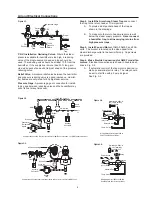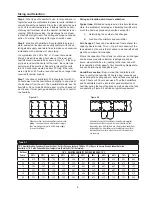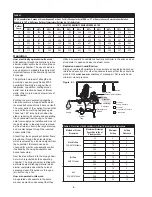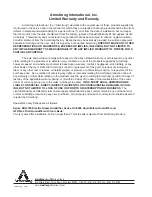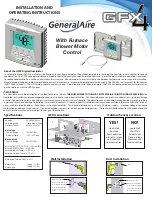
2
Step 3. Run the steam supply line
from the steam
header to the humidi
fi
er as indicated in Fig. 2-1. Observe
the following:
A. Take steam supply line from the top of the supply
main – never from the side or bottom. If several
humidi
fi
ers take steam from a single supply line,
be sure to trap the end of the run-out with an Arm-
strong Trap of suitable size. If the steam supply is
very wet, install a drip pocket or separator ahead
of the humidi
fi
er.
B. Size supply line in accordance with Table 2-1. If
the steam supply is 5 psi or less, it is advisable to
use one pipe size larger and reduce the pipe size
just ahead of the strainer and humidi
fi
er.
C. Pitch the supply line in the direction of
fl
ow.
Humidifi er Piping
D. Expansion and Contraction. With average length
of supply line, the dimension change from hot to
cold should not exceed 2”. Provide piping with 3
elbows to get swing to take care of expansion and
contraction (See Fig. 2-2).
E. Clean piping. After running the supply line, blow
down at full steam pressure to eliminate dirt and
pipe cuttings.
F. A Pipe Strainer is furnished with each humidi
fi
er.
Install (after blowing down supply line) as indi-
cated on drawing.
G. Swivel connections may be desirable – see
Fig. 2-2 and explanatory captions.
H. Pressure Reducing Valve. If required refer to
Fig. 3-1 and explanatory captions.
Table 2-1 Recommended Pipe Sizes
Humidifi er
Size
Supply Header
to Strainer
Steam Inlet
& Strainer
Drip
Leg
Trap
Piping
91
3/4”
3/4”
1”
3/4”
92
3/4”
3/4”
1”
3/4”
93
1-1/4”
1-1/4”
1-1/4”
3/4”
Steam Pipe Capacities
For computing ability of piping to deliver an adequate supply of steam to
humidifi er. Capacities shown are in pounds per hour.
Table 2-2 Steam Pipe Capacity at 5 psi
Pipe
Size in.
Pressure drop, psi per 100 ft. of pipe length
1/8
1/4
1/2
3/4
1
1
24
31
44
54
62
1-1/4
52
68
97
120
140
1-1/2
81
100
150
180
210
2
160
210
300
370
430
2-1/2
270
350
500
610
710
Table 2-3 Steam Pipe Capacity at 15 psi
Pipe
Size in.
Pressure drop, psi per 100 ft. of pipe length
1/8
1/4
1/2
3/4
1
2
1
27
38
53
65
76
110
1-1/4
59
83
120
140
160
230
1-1/2
91
130
180
220
260
360
2
180
260
370
450
520
740
2-1/2
300
430
600
740
860
1210
Table 2-4 Steam Pipe Capacity at 25 psi
Pipe
Size in.
Pressure drop, psi per 100 ft. of pipe length
1/8
1/4
1/2
3/4
1
2
3/4
15
21
30
37
43
60
1
30
43
61
75
86
122
1-1/4
67
95
130
160
190
260
1-1/2
100
140
210
250
290
410
2
210
300
420
510
590
840
2-1/2
340
490
690
850
980
1380
Table 2-5 Steam Pipe Capacity at 50 psi
Pipe
Size in.
Pressure drop, psi per 100 ft. of pipe length
1/4
1/2
3/4
1
2
5
3/4
27
38
47
54
76
120
1
54
77
94
110
150
240
1-1/4
120
170
210
240
340
530
1-1/2
180
260
320
370
520
830
2
370
530
650
750
1060
1680
2-1/2
620
870
1070
1240
1750
2760
Figure 2-1.
Figure 2-2.
Strainer
Steam
Trap
Dirt
Check
Valve
Take off top of
steam supply
To low
pressure return
Pitch down 1/2" in 10'
Typically pneumatically controlled humidifier installation.
Strainer
Steam
Trap
Dirt
Check
Valve
To low
pressure return
Take off top of
steam supply
Pitch down
1/2" in 10'
Swivel connections shown above permit direction of discharge
to be altered easily. Loosen both unions, adjust direction, then
retighten unions.



